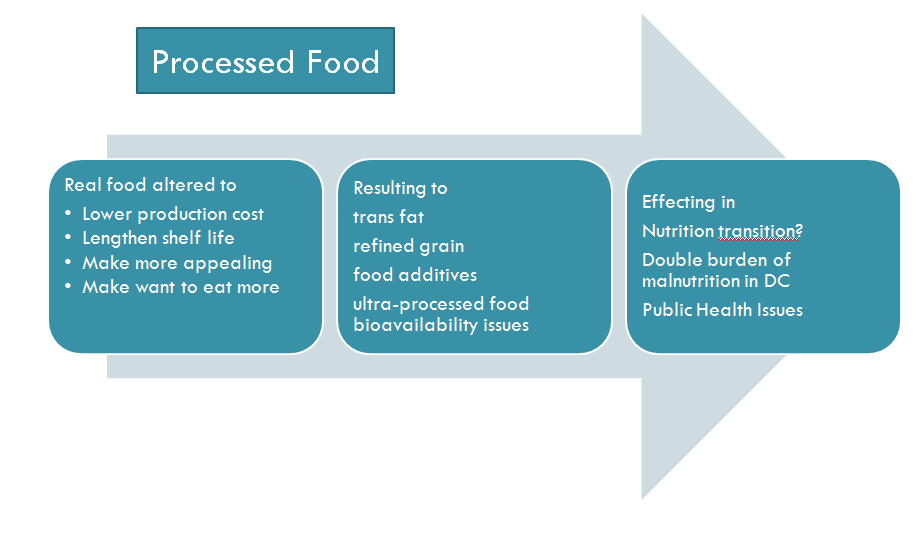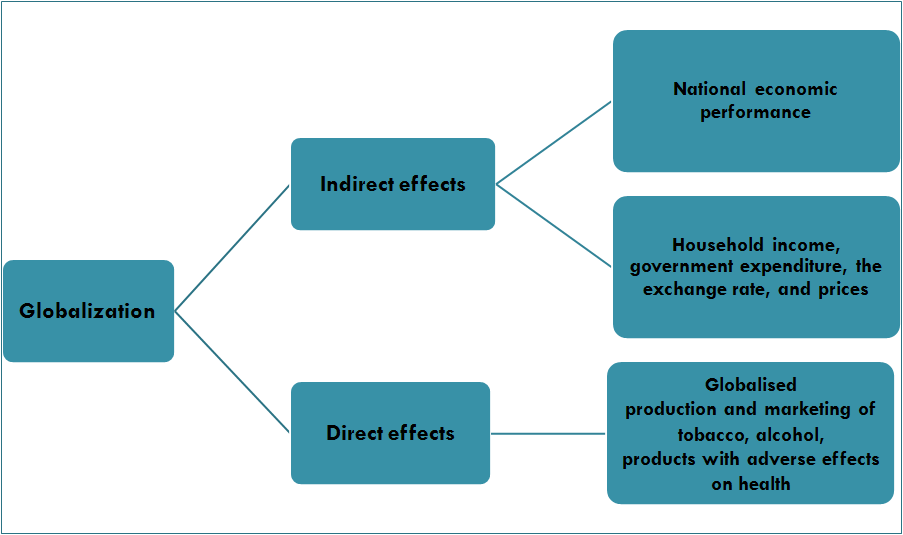Elena Cristea, Sophie Weiss, Margarita Kolomeytseva, Jui Yeasmin
Food availability is referred as to sufficient quantities of food being available for consumption on a consistent basis (World Health Organization, 2013). Many different factors particularly driven by the process of globalization are influencing food availability around the globe. Availability and prices of food are changed through borders open for trade and especially imports. Cultural influences such as migration and tourism introduce new kinds of food. Furthermore the food industry and the presence of transnational corporations that act globally by sourcing their input and output markets in countries all over the world, have particularly been increasing diversity and availability of foodstuffs (Filippaios and Rama, 2008). With the introduction and growth of transnational supermarket chains availability as well as accessibility and prices have been changing (WHO Commission on Social Determinants of Health, 2007). This development initiated both positive and negative effects for developed as well as developing countries. Generally, transnational corporations have brought diversified availability of food including the spectrum from minimal to ultra-processed foods as well as diversity of food and culinary supply (Mak et al., 2012). Their high profits allow investment in research and development in order to enhance technologies improving shelf life, transportation and processing methods for food. Moreover food with nutritional value specifically developed to satisfy special needs such as medical foods can be researched on (Nestlé, 2013). Another important aspect is the ability of transnational companies to facilitate access of smaller companies to foreign markets and in this way giving them support to expand their business (e.g. Südzucker in Moldova).

However, there is always a flip side of the coin. With free trade opportunities only few companies share a particular stage of food chain through vertical and horizontal integration in to the global food market and thereby are destroying the competitive market which is an essential component of free and fair trade (FAO, 2013). Recent data shows that for most of the processing of agricultural products the concentration ratio for 4 companies ranges from 50% to 83% and it is even higher in input sector. In 2007, Nestle and Pepsico had global sale of $90 billion and $98 billion respectively which are more than Gross National Product of many least developed and middle income country (Gereffi, 2009). Very often they influence the food policy makers to present their own interest. Since TNCs spend a lot for promoting their product and in most of the cases they make their ads to attract the children, it eventually returns them as additional sale. TNCs even spread their business to rural area of developing countries through Foreign Direct Investment which has the effect of diminishing the local cultural food habit. They make their product cheaper to catch the poorer consumer and doing so they make it less nutrition dense and more energy dense and very often use harmful chemical for preservative and coloring purpose.

Food business is the type of activity requiring more adaptation from its actors. Even though homogenization of foodstuffs is a phenomenon that is expanding at very fast rates, the diets still remain largely national (Mak et al., 2012). This is an aspect which forces the food industry and TNCs operating in food industry to adapt to local needs. Global products and ideas can be accepted and adapted to suit local needs through “glocalisation” process. When transnational companies start operating on a new market, several strategies can be used (Filippaios and Rama, 2008), (Filippaios and Rama, 2008), (Mak et al., 2012). Strategies such as selling the product without changes on international markets; modifying products for different countries or regions; developing new products for foreign markets (Barbu, 2013) or exploring traditional local products (Danone, 2013). Examples of products modified to satisfy the local needs are the different varieties of burgers offered by McDonalds in different countries. The increased consumption of “falafel” in Israel and the phenomenon of McDonaldisation are further proofs that globalization can lead to the reinvention of local food identities, or act as threat to these identities (Mak et al., 2012).

Furthermore, TNCs are major drivers of the acceleration of the nutrition transition, from traditional diets of whole or minimally processed foods to ultra-processed and energy-dense foods and drinks, and thus the normalization of unhealthy products (Moodie, et al., 2013), (Dummer and Cook, 2008), (Hawkes et al., 2012). Asia is a region where the change in dietary patterns is occurring rapidly passing through the stages of income-induced diet diversification and diet globalization and westernization (Pingali, 2006), (Schmidhuber and Prakash, 2013). These changes in nutrition together with the phenotypic and genotypic predisposition towards a more efficient metabolism and NCDs could result in a fast increase in the obesity and NCDs prevalence over the next generations. Thus, globalization has direct and indirect effects of the development of non-communicable diseases (NCDs). First are illustrated by the globalised production and marketing of alcohol, tobacco, and products with adverse effects on health. The indirect effects are referred to the national economic performance and operate through changes in household income, the exchange rate, government expenditure, and prices (Beaglehole et al., 2003). Promoting changes in food systems the world globalization has been leading to the new challenges and opportunities. While many developing countries are faced with the enduring burden of food insecurity and under-nutrition, modification of diet and physical activity patterns are raising the prevalence of diet-related NCDs, primarily obesity, diabetes, coronary heart disease, and hypertension (WHO, 2003). Sedentary lifestyles and adoption of dietary patterns that can lead to high rates of obesity and NCDs are forced by increasing globalization (FAO, 2004).

As a conclusion, it can be pointed out that the role of food industry is to make good food available at the lowest price possible. Also, transnational companies are becoming more influential and globalization is a process that increases continuously. These phenomena have both positive effects and negative effects. Food is now more available, therefore attention should be given to consumer education for people to be able to choose a correct diet in order to avoid health problems.

Bibliography
Alexander, E, Yach, D, & Mensah, G (2011) Major multinational food and beverage companies and informal sector contributions to global food consumption: implications for nutrition policy, Globalization and Health , S. 7-26.
Barbu, M C (2013) Cultural Adaptation of Products Retrieved March 5, 2013, from http://www.mnmk.ro/: http://www.mnmk.ro/documents/2011/9_Barbu%20FFF.pdf
Beaglehole, R, Yach, D, 2003 Globalisation and the prevention and control of non-communicable disease: the neglected chronic diseases of adults, Lancet 2003; 362: 903–08
Bettcher, D, Lee, K, 2002 Globalisation and public health, J Epidemiologic Community Health, 56; 8-17
Biskou, K, Kontopoulou, C and Saramago, J (2013) Multinational companies in food production – Ethical Issues Retrieved March 1, 2013, from http://bioethics.agrocampus-ouest.eu/: http://bioethics.agrocampus-ouest.eu/infoglueDeliverLive/digitalAssets/41379_Multinational_companies_in_food_production_o.pdf
Bonanno, A, Constance, D H and Lorenz, H (2000) Powers and Limits of Transnational Corporations,Rural Sociology , pp. 440-460.
Cornia, G A, 2001 Globalization and health: results and options, Bulletin of the World Health Organization, 79, 834-841. [Online]. Available: http://www.who.int/bulletin/archives/79(9)834.pdf Accessed: [24 February, 2013].
Danone (2013) Danone in Russia, webdocumentary. Retrieved March 3, 2013, from www.danone.com: http://danone10.danone.com/uk/rubrique/#special_report/webdoc
Dollar, D, 2001 Is globalization good for your health? Bulletin of the World Health Organization,79, 827-833 [Online] Available: http://www.who.int/bulletin/archives/79(9)827.pdf Accessed: [24 February, 2013].
Dummer, T J, & Cook, I G (2008) Health in China and India: A cross-country comparison in a context of rapid globalisation, Social Science and Medicine , 590-605.
FAO (2004) Globalization of food systems in developing countries: impact on food security and nutrition. Retrieved March 4, 2013, from ftp.fao.org: ftp://ftp.fao.org/docrep/fao/007/y5736e/y5736e00.pdf
FAO (2013) Trade Reforms And Food Security. Retrieved March 5, 2013, from http://www.fao.org/documents/en/docrep.jsp
FAO 2004 Globalization of food systems in developing countries: impact on food security and nutrition. [Online]. Available: ftp://ftp.fao.org/docrep/fao/007/y5736e/y5736e00.pdf Accessed: [25 February, 2013]
Filippaios, F and Rama, R (2008) Globalisation or regionalisation? The strategies of the world’s largest food and beverage MNE’s. European Management Journal , 59-72.
Filippaios, F, Papanastassiou, M, Pearce, R and Rama, R (2009) New forms of organisation and R&D internationalisation among the world’s 100 largest food and beverages multinationals, Research Policy , 1032–1043.
Fresco, L O (2009) Challenges for food system adaptation today and tomorrow, Environmental Science and Policy , 378-385.
Gereffi, G (2009) Trade , Transnational Corporations and Food Consumption : A Global Value Chain Approach
FAO 2012 Undernourishment around the world in 2012 [Online] Available: http://www.fao.org/docrep/016/i3027e/i3027e02.pdf Accessed: [28 February, 2013]
Hawkes, C, 2002 Marketing activities of global soft drink and fast food companies in emerging markets: a review. In: World Health Organization, Globalization, Diets and Non-communicable Diseases. Geneva: World Health Organization
Hawkes, C, 2006 Uneven dietary development: linking the policies and processes of globalization with the nutrition transition, obesity and diet-related chronic diseases, Global Health, 2, 4.
Hawkes, C, Friel, S, Lobstein, T and Lang, T (2012) Linking agricultural policies with obesity and noncommunicable diseases: A new perspective for a globalising worls, Food Policy , 343-353.
Hendrickson, M and Heffernan, W, 2005 Concentration of Agricultural Markets: February 2005. [Online] Available: http://www.nfu.org/issues/economic-policy/resources/heffernan-report/ National Farmers Union (United States) Accessed: [20 February, 2013].
Ioannou, I, Hafsa, I, Hamdi, S, Charbonnel, C and Ghoul, M (2012) Review of the effects of food processing and formulation on flavonol and anthocyanin behaviour, Journal of Food Engineering, 111(2), 208–217. doi:10.1016/j.jfoodeng.2012.02.006
Jolly, C M, Jackson, J D and Thompson, H (1992), Vertical Integration (pp. 1967–1992).
Kearney, J, 2010 Food Consumption Trends and Drivers Phil Trans. R. Soc. B 365, 2793–2807.
King, H, Aubert, R H, Herman, W H (1998) Global burden of diabetes, 1995-2025: prevalence, numerical estimates, and projections. Diabetes care, 21(9) : 1414-1431
Leigh, H, Centre, C and Kingdom, U (n.d.). The Global Food System : A Research Agenda, 1–19
Mak, A N, Lumbers, M and Eves, A (2012) Globalisation and food consumption in tourism, Annals of Tourism Research , 171-196.
Mendez, M A, Popkin, B M (2004) Globalization, urbanization and nutritional change in the developing world, FAO Food and Nutrition Paper, 55-80.
Mesías, M, Seiquer, I and Navarro, M P (2012) Consumption of highly processed foods : Effects on bioavailability and status of zinc and copper in adolescents, FRIN, 45(1), 184–190 doi:10.1016/j.foodres.2011.09.030
Monteiro, C A and Cannon, G (2012) The Impact of Transnational “Big Food” Companies on the South: A View from Brazil, Plos Medicine , 13-18.
Moodie, R, Stuckler, D, Monteiro, C, Sheron, N, Neal, B, Thamarangsi, T (2013) Profits and pandemics: prevention of harmful effects of tobacco, alcohol, and ultra-processed food and drink industries, Lancet , 670-679.
Murray, W E (2001) The second wave of globalisation and agrarian change in the Pacific Islands, Journal of Rural Studies , 135-148.
Nestle (2013) Personalised nutrition Retrieved March 5, 2013 from http://www.nestle.com/: http://www.nestle.com/nhw/personalised-nutrition
Pingali, P (2006). Westernization of Asian diets and the transformation of food systems: Implications for research and policy, Food Policy , 281-298.
Rennie, K L, Johnson, L, Jebb, S A (2005) Behavioural determinants of obesity, Best Pract Res Clin Endocrinol Metab, 19(3):343-58
Schmidhuber, J and Prakash, S (2013) The nutrition transition to 2030. Why developing countries are likely to bear the major burden, Rome: FAO.
UNEP (2012) The critical role of global food consumption patterns in achieving sustainable food systems and food for all [Online] Available: http://www.unglobalcompact.org/docs/news_events/upcoming/RioCSF/partner_deliverables/Role_of Global_Food_Consumption_Patterns.pdf Accessed: [23 February, 2013].
Unilever (2013) Making products healthier, Retrieved March 4, 2013, from http://www.unilever.com/: http://www.unilever.com/sustainable-living/nutrition-health/making-our-products-healthier/index.aspx
Watson, J L (1997) Golden Arches East: McDonald’s in East Asia, Stanford, California: Stanford University Press
WHO Commission on Social Determinants of Health (2007) Globalization, Food and Nutrition Transitions, [Online]. Available: http://www.who.int/social_determinants/resources/gkn_hawkes.pdf Accessed: [22 February, 2013]
WHO Commission on Social Determinants of Health, 2007. Globalization, Global Governance and the Social Determinants of Health: A review of the linkages and agenda for action. [Online]. Available: http://www.who.int/social_determinants/resources/gkn_lee_al.pdf Accessed: [22 February, 2013].
WHO (2003) Diet, Nutrition and the Prevention of Chronic Diseases, [Online] Available: http://whqlibdoc.who.int/trs/who_trs_916.pdf Accessed: [27 February, 2013]
WHO (2002) Globalization, Diets and Non-communicable Diseases [Online] Available: http://whqlibdoc.who.int/publications/9241590416.pdf Accessed: [28 February, 2013].
WHO (2011) NCD Country Profiles, Russia [Online] Available: http://www.who.int/nmh/countries/rus_en.pdf Accessed: [28 February, 2013]
Wild, S, Roglic, G, Green, A, Sicree, R, King, H (2004) Global prevalence of diabetes: estimates for the year 2000 and projections for 2030, Diabetes Care, 27(5):1047-53.
Woodward, D, Drager, N, Beaglehole, R, Lipson, D (2001) Globalization and health: a framework for analysis and action, Bulletin of the World Health Organization, 79: 875–881
World Health Organization2013www.who.int
Yach, D, Khan, M, Bradley, D, Hargrove, R, Kehoe, S and Mensah, G (2010) The role and challenges of the food industry in addressing chronic disease, Globalization and Health , pp. 6-10.
WHO (2002) Diets and Noncommunicable Diseases



2 Comments
Susant
Great article! I appreciate the clear and insightful perspective you’ve shared. It’s fascinating to see how this topic is developing. For those interested in diving deeper, I found an excellent resource that expands on these ideas: check it out here. Looking forward to hearing others’ thoughts and continuing the discussion!
Oliviat
This piece provided some great insights. The author’s approach was both clear and engaging. I’m curious to see how others feel about these ideas. Any additional thoughts?